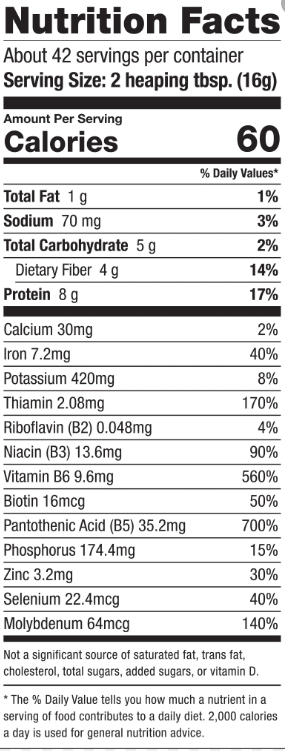It is a really dense source of quality protein, B vitamins, minerals, and it’s even pretty tasty — if you know how to use it properly. We’ll cover all of that, and more, as we go along in today’s article. I think you’ll like what you find.
What Is Nutritional Yeast?
Basically, nutritional yeast is what we might otherwise know as deactivated saccharomyces cerevisiae. Yeast is a very large family of organisms, and this is one of them.
When it comes to yeasts, and all the different kinds, many of them are benign, some of them are harmful, and many are simply neutral (neither good nor bad).
There are thoughts out there about yeast being bad for us. Things about yeast overgrowth and yeast infections may be true (in that they happen), but it is a broad category — meaning that nutritional yeast does not apply in this context.
When the body does get yeast overgrowth, it is not so much a question of catching the yeast, but it is more commonly an issue of poor immune regulation. This is where the body may not be maintaining its own flora in a proper fashion.
IBD & Nutritional Yeast
I have had a good number of savvy viewers mention this to me.
The concern here is that there are yeast antibodies in, specifically saccharomyces antibodies, present in the case of inflammatory bowel disease (Read More: Myths, Facts, and Action Steps for Irritable Bowel Syndrome).
So, let’s begin by stating that saccharomyces is a genus. While there are different species, some species are normal residents of the bowel flora.
In the case of IBD, researchers have tried to find some good markers (blood antibody markers) to predict the disease and showcase its severity. To this point, they have not found many.
That said, anti-saccharomyces antibodies are ones they have found. It is not so much, though, that yeast is causing IBD, but more so that with the inflammation that type of yeast is one of the items that can come under attack.
However, the immune system, in its error, can attack thyroglobulin. That is a measurable way to diagnose thyroid disease and to gauge its progress.
The Argument for Nutritional Yeast
All that in mind, why might you want to consider adding nutritional yeast into your diet?
To put it simply, it is an awesome source of a lot of nutrients! Let’s consider the following image, which is a label you can find on a package of nutritional yeast.

- 8 grams of complete protein
- 4 grams of fiber
- 7.2 mg Fe
- 420 mg K
- 13.6 mg niacin
- 9.6 mg B6
- 16 mcg biotin
- 35 mg B5
- 3.2 mg Zn
- 22 mcg Se
- 84 mcg Mb
- 25 mg Mg
In addition to that, nutritional yeast also offers:
- Selenium
- A complete plant protein
- B-12 (present only when fortified)
Fortified Versus Non-Fortified
A lot of brands of nutritional yeast have been fortified, meaning that they have had B vitamins added into them. Those can include:
- Thiamine
- Riboflavin
- Niacin
- B6
- B5
- Folic Acid
- B12
Those are the typical ones that are added into the mix.
Now, the folic acid that is added in is synthetic folic acid. If you have seen some of my work on methylation, you might know that folic acid is typically good to avoid for those who have poor methylation.
Folate is good when it is naturally occurring in different foods, but folic acid is better to avoid. There are many, though, that feel vaguely not well from mega doses of B vitamins. It may leave you feeling overstimulated, edgy, or just plain antsy.
I don’t know for certain if that is real, but I do tend to feel that myself. So, I feel better when I avoid megadoses of B vitamins to avoid this feeling altogether.
Fortified Yeast and B12
Fortified yeast is often discussed as a source of B12 for vegans, however, it is worth knowing that the B12 is not naturally part of the yeast.
Some have argued that unfortified yeast contains a certain kind of B12, and maybe there is a similar molecule, but there is no data suggesting that there is a biologically active form of B12 that you may be able to find in unfortified nutritional yeast.
Nutritional Yeast and Phytochemicals

The two of these are as follows:
- Alpha Mannan
- Beta Glucan
Alpha mannan has been shown to inhibit the ability of infectious bacteria to hold onto the intestinal lining1.
Beta-glucan, which can be found in oats, have been known to help regulate immunity, take away tendencies toward autoimmunity, while lowering LDL cholesterol and decreasing inflammation in the body2.
Nutritional Yeast: Action Steps
So, now that you know more about it, what can you do with nutritional yeast?
This reminded me of my family’s trip to Italy this past summer. While there, we obviously enjoyed a lot of great food. And it feels like, with almost every dish we had, everything was topped off with grated parmesan cheese.
Nutritional yeast is very close to that flavor. It is salty, has an umami kick, and the commonly-found granulated forms have a bit of texture to them.
- Soups
- Stews
- Stir Frys
- Smoothies (maybe not too much)
One classic recipe where you’ll find nutritional yeast is with popcorn. While you may not want to have it too frequently, and when you do have it it’s best to use air-popped organic popcorn, nutritional yeast can be a delicious accompaniment.
But, the one issue that you’ll likely have is that nutritional yeast, in its original form, has a hard time adhering to popcorn. So, grab a blender and “powder” your yeast by blending it for a few minutes. It’ll turn into a fine powder that will stick more readily (with some oil from a mister).
You can also roast some garbanzo beans and add some nutritional yeast to coat them, afterward. Or, it can work exceptionally in a whole host of different dips (think of hummus or non-dairy yogurt dips to start).
Enjoy Some Nutritional Yeast Today
I really hope this conversation today has helped to expand your perspective on the idea of nutritional yeast, and how it might be able to benefit your health.
If there are any unfortified brands of nutritional yeast that you trust, or that you are a fan of, I’d love to hear about them. Please feel free to share them with me.
Start Testing Your Thyroid
While you’re here, I’d love for you to try the Thyroid Quiz (Click Here: Take The Quiz Today) to learn more about the health of your thyroid, where it currently stands, and some action steps you can take today to help safeguard your health.
Resources
2 – https://www.ncbi.nlm.nih.gov/pubmed/28872611

1. Schedule a Thyroid Second Opinion with me, Dr. C, Click Here for Details
2. Download and use my Favorite Recipes Cookbook Here
3. Check out my podcast Medical Myths, Legends, and Fairytales Here
Dr. Alan Glen Christianson (Dr. C) is a Naturopathic Endocrinologist and the author of The NY Times bestselling Adrenal Reset Diet, The Metabolism Reset Diet and The Thyroid Reset Diet.
Dr. C’s gift for figuring out what really works has helped hundreds of thousands of people reverse thyroid disease, lose weight, diabetes, and regain energy. Learn more about the surprising story that started his quest.


